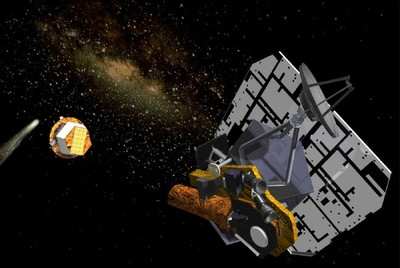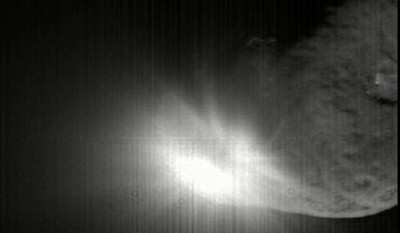Aims Largest Telescope At Five Stars
NASA's Deep Impact spacecraft is aiming its largest telescope at
five stars in a search for alien (exosolar) planets as it enters
its extended mission, called Epoxi.

As ANN reported, Deep Impact
made history when the mission team directed an impactor from the
spacecraft into comet Tempel 1 on July 4, 2005. NASA recently
extended the mission, redirecting the spacecraft for an October 11, 2010 flyby of
comet Hartley 2.
As it cruises toward the comet, Deep Impact will observe five
nearby stars with "transiting exosolar planets," so named because
the planet transits, or passes in front of, its star. The Epoxi
team, led by University of Maryland astronomer Michael A'Hearn,
directed the spacecraft to begin these observations January 22. The
planets were discovered earlier and are giant planets with massive
atmospheres, like Jupiter in our solar system. They orbit their
stars much closer than Earth does the sun, so they are hot and
belong to the class of exosolar planets nicknamed "Hot
Jupiters."
However, these giant planets may not be alone. If there are
other worlds around these stars, they might also transit the star
and be discovered by the spacecraft. Deep Impact can even find
planets that don't transit, using a timing technique. Gravity from
the unseen planets will pull on the transiting planets, altering
their orbits and the timing of their transits.
"We're on the hunt for planets down to the size of Earth,
orbiting some of our closest neighboring stars," said Epoxi Deputy
Principal Investigator Drake Deming of NASA's Goddard Space Flight
Center in Greenbelt, MD. Epoxi is a combination of the names for
the two extended mission components: the exosolar planet
observations, called Extrasolar Planet Observations and
Characterization (Epoch), and the flyby of comet Hartley 2, called
the Deep Impact Extended Investigation (Dixi). Goddard leads the
Epoch component.
More than 200 exosolar planets have been discovered to date.
Most of these are detected indirectly, by the gravitational pull
they exert on their parent star. Directly observing exosolar
planets by detecting the light reflected from them is very
difficult, because a star's brilliance obscures light coming from
any planets orbiting it.
However, sometimes the orbit of an exosolar world is aligned so
that it eclipses its star as seen from Earth. In these rare cases,
called transits, light from that planet can be seen directly.
"When the planet appears next to its star, your telescope
captures their combined light. When the planet passes behind its
star, your telescope only sees light from the star. By subtracting
light from just the star from the combined light, you are left with
light from the planet," said Deming, who is leading the search for
exosolar worlds with Deep Impact. "We can analyze this light to
discover what the atmospheres of these planets are like."

Deep Impact will also look back to observe Earth in visible and
infrared wavelengths, allowing comparisons with future discoveries
of Earth-like planets around other stars.
NASA's Jet Propulsion Laboratory, Pasadena, CA, manages Epoxi
for NASA's Science Mission Directorate, Washington. The University
of Maryland is the Principal Investigator institution. NASA Goddard
leads the mission's exosolar planet observations. The spacecraft
was built for NASA by Ball Aerospace & Technologies Corp.,
Boulder, CO.
 ANN's Daily Aero-Linx (04.13.24)
ANN's Daily Aero-Linx (04.13.24) ANN's Daily Aero-Term (04.13.24): Beyond Visual Line Of Sight (BVLOS)
ANN's Daily Aero-Term (04.13.24): Beyond Visual Line Of Sight (BVLOS) Airborne 04.09.24: SnF24!, Piper-DeltaHawk!, Fisher Update, Junkers
Airborne 04.09.24: SnF24!, Piper-DeltaHawk!, Fisher Update, Junkers Aero-News: Quote of the Day (04.14.24)
Aero-News: Quote of the Day (04.14.24) ANN's Daily Aero-Term (04.14.24): Maximum Authorized Altitude
ANN's Daily Aero-Term (04.14.24): Maximum Authorized Altitude




